-
Gravitational wave signals from the coalescence of compact binaries were detected by the LIGO Scientific Collaboration and Virgo Collaboration [1] for the first time in 2015. This landmark detection has ushered in a new frontier of general relativity testing and universe exploration [2−7]. One promising prospect is the analysis of the quasinormal modes (QNMs) in a ringdown waveform. These oscillation frequencies are determined by the mass and angular momentum of a remnant black hole. Empirical detection of QNMs would not only provide us with an opportunity to test the no-hair theorem [8−11] but also allow us to constrain the alternative theory [12−15]. To this end, the technological conditions for larger signal-to-noise ratios (SNRs) are required. Ground-based gravitational wave detectors (such as LIGO, Virgo, and KAGRA) operate in frequency bands above 10 Hz and suffer the influence of the gravity gradient and seismic noise, which leads to the ringdown signal being neglected for short durations. For the proposed space-based gravitational wave detectors, the frequency bands dip to the millihertz frequency band, where numerous sources are waiting to be probed. It is possible for future space-based observations such as LISA, TaiJi, and TianQin to detect ringdown signals from intermediate and supermassive sources with large SNRs. On this basis, the window for testing the nature of gravity will be opened, which is significant.
Einstein’s theory of general relativity, as the cornerstone of modern gravitational theories, describes the most beautiful physical world at macroscopic scales. However, such a prevailing theory is plugged with the black hole singularity, dark matter and dark energy, and non-renormalization problems, which indicate that general relativity is not a complete theory of gravity. A variety of alternative theories of gravity have been proposed from the complexities of curvature in general relativity, such as the Lovelock [16],
$ f(R) $ [17], and$ f(T) $ [18] theories. As a higher-curvature gravity theory motivated by the low-energy limit in string gravity [19], Einstein-dilaton-Gauss-Bonnet (EdGB) gravity is formulated to as a dilaton scalar field coupled to the Gauss-Bonnet invariant with the coupling parameter$ {{\alpha _{{\rm{GB}}}}} $ in the action [20, 21]. As a consequence, the field equations are always of the second order and this gravity is ghost-free. Furthermore, black holes and neutron stars can be scalarized spontaneously in this theory [22−24]. The presence of a nontrivial scalar field outside its horizon leads to the violation of the classical "no-hair" theorems [ 25], and thus the resultant hairy black holes cannot be described by the Kerr hypothesis. There are many attractive features in EdGB gravity that have led to observable implications [4, 26].At present, with the development and gradual maturity of technology, not only is EdGB gravity constrained by astronomical observations [27−29] but also by gravitational wave data from binary black holes [30−32] and numerical relativity simulation [33, 34]. Here, inspired by the significance of QNM corrections for massive black holes in EdGB gravity [13, 35] and sufficiently high SNRs with space-based gravitational wave detectors, we investigate the ability to estimate the accuracy of the dimensionless deviating parameter with LISA, TaiJi, and TianQin in the parameterized ringdown signal. According to the standard dimensional analysis, the dimensionful coupling parameter
$ {{\alpha _{{\rm{GB}}}}} $ leads to negligible deviations in the low energy regime, equivalently at the scale of supermassive black holes. However, owing to the lack of a complete quantum theory of gravity, it is better to resort to experiment data to constrain the deviation to general relativity independently at the supermassive black hole scale and stellar-origin black hole scale. With this in mind, we focus mainly on space-based gravitational wave detectors, with a supermassive black hole as the target. First, we construct the ringdown waveform with the two strongest QNMs in EdGB gravity. The black hole in question is extremely slowly-rotating with the first order in rotation, whose QNMs in gravitational perturbations naturally return to Kerr spacetime as the dimensionless deviating parameter fades away [36]. To further improve the SNR, it is essential to eliminate different noise. The laser frequency noise in an unequal-arm interferometer is not negligible [37]. To suppress laser noise, the time-delay interferometry (TDI) combination has been proposed [38]. In this paper, we choose the first-generation TDI Michelson combination X [38] to obtain response functions and the noise power spectral density. Then, the SNR is calculated to assess the scientific performance of LISA, TaiJi, and TianQin. Furthermore, the effects of the arm length of the detector, the mass, the luminosity distance, the spin of the remnant black hole, the symmetric mass ratio, and the dimensionless deviating parameter on the measurement errors of the dimensionless deviating parameter are further probed. In particular, we present the maximum constraint on the dimensionless deviating parameter for EdGB gravity with ringdown signals from massive binary black holes. To verify the conclusions, we also perform simulations of Bayesian inference to obtain probability distributions of the dimensionless deviating parameter.The remainder of our paper is organized as follows. In the next section, we give a brief introduction to EdGB gravity, including the black hole solution and QNMs of gravitational field perturbation for slowly-rotating black holes. In Sec. III, we present the ringdown signals of TDI Michelson combination X and the sensitivity curves of space-based gravitational wave detectors. In Sec. IV, we calculate the SNR and use the Fisher information matrix to analyze how measurement errors of the dimensionless deviating parameter can be affected by the arm length of the detector, the mass, the luminosity distance, the spin of the remnant black hole, the symmetric mass ratio, and the dimensionless deviating parameter. The maximum capacity of the constraint on the dimensionless deviating parameter for EdGB gravity with LISA and TianQin is also presented. Then, in Sec. V, Bayesian parameter estimation is performed on simulated data to verify the reliability of the conclusion. The concluding remarks are provided in the last section.
-
Let us start with the action for EdGB gravity [20, 21],
$ \begin{equation} S = \int {{{\rm d}^4}} x\frac{{\sqrt { - g} }}{{16\pi }}\left( {R - \frac{1}{2}{\partial _\mu }\phi {\partial ^\mu }\phi + \frac{{{\alpha _{\rm GB}}}}{4}{{\rm e}^\phi }R_{\rm GB}^2} \right) + {S_m}, \end{equation} $

(1) where
$ {S_m} $ is the matter sector, g denotes the determinant of the metric, R is the Ricci scalar, ϕ is a dynamical scalar field,$ {{\alpha _{{\rm{GB}}}}} $ is the coupling parameter with the dimensions of a quadratic length, and$ {{\cal R}_{{\rm{GB}}}^2} $ is the Gauss-Bonnet invariant expressed as$ \begin{equation} {\cal R}_{{\rm{GB}}}^2 = {R_{\mu \nu \rho \sigma }}{R^{\mu \nu \rho \sigma }} - 4{R_{\mu \nu }}{R^{\mu \nu }} + {R^2}. \end{equation} $

(2) When EdGB gravity was proposed, the construction of black hole solutions garnered considerable interest [39−42]. In general, a small-coupling regime [20, 41] is adopted to simplify the calculation as one confronts the problem of clumsy equations in the analytical solution. For spinning EdGB black holes, the field equation can be solved by expanding the spin
$ {\chi _f} \ll 1 $ and dimensionless deviating parameter$ \dfrac{{{\alpha _{{\rm{GB}}}}}}{{{M^2}}} \ll 1 $ to the ideal order. In comparison with Kerr black holes, they possess a minimal mass and larger angular momentum [40, 43−45].To simplify the notation, the dimensionless deviating parameter is given by
$ \begin{equation} \zeta = \frac{{{\alpha _{{\rm{GB}}}}}}{{{M^2}}}, \end{equation} $

(3) where M is the mass of the black hole.
Furthermore, QNMs have been extensively studied in EdGB gravity [36, 46−48]. For our purpose, we only focus on the gravitational-led QNMs of extremely slowly-rotating black holes with first order in the spin. The resultant QNMs can be modeled as [36]
$ \begin{equation} {\omega ^{nlm}}({\chi _f},\zeta ) = \omega _0^{nl}(\zeta ) + {\chi _f}m\omega _1^{nl}(\zeta ). \end{equation} $

(4) Here,
$ \omega _0^{nl} $ denotes the QNMs of a non-rotating black hole in the polar sector [47],$ \omega _1^{nl} $ represents the QNMs of spin corrections,$ {\chi _f} $ is the dimensionless spin and$ {\chi _f} = J/{M^2} $ , where J is the spin angular momentum of the black hole, and m is the azimuthal number. Specifically, for the lowest-lying QNMs with the multipole number$ l = 2,3 $ , the analytic fitting formula reads as [36, 46]$ \begin{aligned}[b] M\omega _0^{0l} =& (1 + {f_1}{\zeta ^2} + {f_2}{\zeta ^3} + {f_3}{\zeta ^4})\omega _s^{0l},\\ M\omega _1^{0l} =& {q_1} + {q_2}{\zeta ^2} + {q_3}{\zeta ^3} + {q_4}{\zeta ^4} + {q_5}{\zeta ^5} + {q_6}{\zeta ^6}. \end{aligned} $

(5) Here,
$ \omega _s^{0l} $ denotes the QNMs of Schwarzschild spacetime. For the modes with$ l = 2 $ ,$ M{\omega _s^{02}} \approx 0.37370 - 0.08896i $ . For the modes with$ l = 3 $ ,$ M{\omega _s^{03}} \approx 0.5994 - 0.0927i $ . The coefficients$ {f_i} $ and$ {q_i} $ are listed in Table 1. As the dimensionless deviating parameter tends to zero, the QNMs of EdGB gravity fall into Kerr spacetime [36, 48, 49].$ (l,m) $ 

QNMs $ {f_1} $ 

$ {f_2} $ 

$ {f_3} $ 

$ {q_1} $ 

$ {q_2} $ 

$ {q_3} $ 

$ {q_4} $ 

$ {q_5} $ 

$ {q_6} $ 

(2,2) $ {\omega _R} $ 

−0.03135 −0.09674 0.23750 0.06290 −0.01560 −0.00758 −0.06440 0.26800 −0.60300 $ {\omega _I} $ 

0.04371 0.17940 −0.29470 0.00099 −0.00110 0.01864 −0.17271 0.56422 −0.81190 (3,3) $ {\omega _R} $ 

−0.09911 −0.04907 0.09286 0.06740 −0.02910 0.02510 −0.32090 1.17030 −1.33410 $ {\omega _I} $ 

0.07710 0.13990 −0.34500 0.00065 0.00023 0.02330 −0.28320 1.32300 −2.44200 The dependence of the relative departures between the QNMs of Kerr black holes on the dimensionless deviating parameter ζ for different spins
$ {\chi _f} $ is illustrated in Fig. 1, where$ \delta \omega _{R,I}^{nlm} = \left({\omega _{R,I}^{nlm}(\zeta) - \omega _{R,I}^{nlm}(0)} \right)/\omega _{R,I}^{nlm}(0) $ . We note that as the spin increases, the relative departures of the real and imaginary parts of the QNMs increase, which implies that the correction of QNMs in EdGB gravity can be magnified by the spin. -
The ringdown waves from a distorted black hole consist of the plus component
$ {h_ + } $ and cross component$ {h_ \times } $ , which are dominated by the forms$ \begin{aligned}[b] {h_ + }(t) =& \frac{{{M}}}{{{D_L}}}\sum\limits_{l,m} {{A_{lm}}} Y_ + ^{lm}(\iota ){{\rm e}^{ - t/{\tau _{lm}}}}\cos \left( {{\omega _{lm}}t - m{\phi _0} } \right),\\ {h_ \times }(t) = & - \frac{{{M}}}{{{D_L}}}\sum\limits_{l,m} {{A_{lm}}} Y_ \times ^{lm}(\iota ){{\rm e}^{ - t/{\tau _{lm}}}}\sin \left( {{\omega _{lm}}t - m{\phi _0} } \right), \end{aligned} $

(6) for
$ t \ge {t_0} $ , and$ {h_{ +, \times }}(t) = 0 $ for$ t < {t_0} $ , where$ {t_0} $ is the initial time of ringdown. Here,$ {{M}} $ is the mass of the final black hole,$ {{D_L}} $ is the luminosity distance to the source, l and m are the harmonic indices,$ {A_{lm}},{\phi _0} $ are the amplitude and initial phase of the QNMs,$ {\tau _{lm}},{\omega _{lm}} $ are the damping time and oscillation frequency of the QNMs determined by Eq. (4) in EdGB gravity, and$ \iota \in \left[{0,\pi } \right] $ is the inclination angle of the remnant. The function$ Y_{ +, \times }^{lm}(\iota) $ indicates the total of$ -2 $ weighted spin spheroidal harmonics, which can be expressed as [50]$ \begin{aligned}[b] {Y_ + ^{lm}(\iota ){ = _{ - 2}}{Y^{lm}}(\iota ,0) + {{( - 1)}^l}_{ - 2}{Y^{l - m}}(\iota ,0),}\\ {Y_ \times ^{lm}(\iota ){ = _{ - 2}}{Y^{lm}}(\iota ,0) - {{( - 1)}^l}_{ - 2}{Y^{l - m}}(\iota ,0).} \end{aligned} $

(7) To construct the ringdown waveform, we focus only on two dominant modes,
$ l = m = 2,3 $ , in EdGB gravity. More specifically,$ \begin{aligned} Y_ + ^{22}(\iota ) =& \sqrt {\frac{5}{{4\pi }}} \frac{{1 + {{\cos }^2}\iota }}{2},Y_ \times ^{22}(\iota ) = \sqrt {\frac{5}{{4\pi }}} \cos \iota, \\ Y_ + ^{33}(\iota ) = & - \sqrt {\frac{{21}}{{8\pi }}} \frac{{1 + {{\cos }^2}\iota }}{2}\sin \iota ,Y_ \times ^{33}(\iota ) = - \sqrt {\frac{{21}}{{8\pi }}} \sin \iota \cos \iota. \end{aligned} $

(8) Moreover,
$ {A_{lm}} $ is well fitted as [51, 52]$ \begin{equation} \begin{array}{l} {A_{22}}(\nu ) = 0.864\nu ,\\ {A_{33}}(\nu ) = 0.44{(1 - 4\nu )^{0.45}}{A_{22}}(\nu ). \end{array} \end{equation} $

(9) Here,
$ \nu = {m_1}{m_2}/{\left({{m_1} + {m_2}} \right)^2} $ is the symmetric mass ratio, and$ {m_1},{m_2} $ are the masses of two separated black holes before coalescence.Now, we exploit the first generation TDI Michelson combination X [38] to obtain the frequency-domain ringdown signals, which can be written as
$ \begin{equation} h(f) = \sum\limits_{A = + , \times } {\frac{1}{2}(1 - {{\rm e}^{ - 2iu}})(D_u^A{\cal T}(u,\hat n \cdot \hat u) - D_v^A{\cal T}(u,\hat n \cdot \hat v)){h_A}(f)}, \end{equation} $

(10) where
$ {h_{ +, \times }}(f) $ are the frequency-domain ringdown signals after the Fourier transformation of$ {h_{ +, \times }}(t) $ ,$\begin{aligned}[b] D_u^ + =& \left[ {{{\cos }^2}\theta {{\cos }^2}(\phi - \pi /6) - {{\sin }^2}(\phi - \pi /6)} \right]\cos 2\psi \\& - \cos \theta \sin (2\phi - \pi /3)\sin 2\psi, \\ D_u^ \times =& - \cos \theta \sin (2\phi - \pi /3)\cos 2\psi \\&- \left[ {{{\cos }^2}\theta {{\cos }^2}(\phi - \pi /6) - {{\sin }^2}(\phi - \pi /6)} \right]\sin 2\psi, \\ D_v^ + =& \left[ {{{\cos }^2}\theta {{\cos }^2}(\phi + \pi /6) - {{\sin }^2}(\phi + \pi /6)} \right]\cos 2\psi \\& - \cos \theta \sin (2\phi + \pi /3)\sin 2\psi, \\ D_v^ \times = & - \cos \theta \sin (2\phi + \pi /3)\cos 2\psi \\&- \left[ {{{\cos }^2}\theta {{\cos }^2}(\phi + \pi /6) - {{\sin }^2}(\phi + \pi /6)} \right]\sin 2\psi. \end{aligned} $

(11) The frequency-dependent transfer function
$ {\cal T} $ is$ \begin{aligned}[b] {\cal T}(u,\hat n \cdot \hat u) =& \frac{1}{2}{{\rm e}^{ - iu}}\Big[ {{\rm e}^{ - iu(1 - \hat n \cdot \hat u)/2}}{\rm{sinc}}\left( {u(1 + \hat n \cdot \hat u)/2} \right) \\&+ {{\rm e}^{iu(1 + \hat n \cdot \hat u)/2}}{\rm{sinc}}\left( {u(1 - \hat n \cdot \hat u)/2} \right) \Big]. \end{aligned} $

(12) Here,
$ u = \dfrac{{2\pi fL}}{c} $ , where L is the arm length of the detector, and c is the speed of light,$ {\rm{sinc}}(z) = \dfrac{{{\rm{sin }}z}}{z} $ ,$\hat n = \left({\sin \theta \cos \phi, \sin \theta \sin \phi,\;\cos \theta } \right)$ is the orientation of the source, and the unit vectors with respect to the detector's arms,$\hat u,\;\hat v$ , are$ \begin{equation} \hat u = \left( {\cos \frac{\pi }{6},\sin \frac{\pi }{6},0} \right),\hat v = \left( {\cos \frac{\pi }{6}, - \sin \frac{\pi }{6},0} \right). \end{equation} $

(13) For convenience, Fig. 2 shows the detector coordinate system adopted in this study. The origin is placed at spacecraft 1.
$ (\hat p,\hat q,\hat k) $ are the basis vectors of the canonical reference frame, where$ \hat k $ denotes the direction of propagation of gravitational waves,$ (\hat \phi,\hat \theta,\hat n) $ are the basis vectors of the observational reference frame, and ψ is the polarization angle.To test EdGB gravity with space-based gravitational wave detectors, it is necessary to evaluate the capability of LISA, TaiJi, and TianQin. Here, we adopt the noise power spectral density and average response functions of tensor polarizations for the Michelson combination X [53]:
$ \begin{equation} {S_N}{(u)_X} = \frac{{4{{\sin }^2}u}}{{{u^2}}}\left[ {\frac{{s_a^2{L^2}}}{{{u^2}{c^4}}}(3 + \cos 2u) + \frac{{{u^2}s_x^2}}{{{L^2}}}} \right], \end{equation} $

(14) $ \begin{aligned}[b] R{(u)_X} =& \dfrac{{{{\sin }^2}u}}{{2{u^2}}}[( - 7\sin u + 2\sin 2u)/u \\&+ ( - 4 + 5\cos u - 4\cos 2u)/{u^2} \\&+ ( - 5\sin u + 4\sin 2u)/{u^3}\\ & + (5 + \cos 2u)/3 - 6\cos 2u(Ciu - 2Ci2u \\&+ Ci3u + \ln 4/3) + 4(Ciu - Ci2u + \log 2)\\& - 6\sin 2u(Siu - 2Si2u + Si3u)], \end{aligned} $

(15) where SinIntegral
$\operatorname{Si}(z)=\int_0^z(\sin t / t) {\rm d} t$ , CosIntegral$\operatorname{Ci}(z)= -\int_z^{\infty}(\cos t / t) {\rm d} t$ ,$ {S_a} $ is the residual acceleration noise, and$ {S_x} $ is the displacement noise. For LISA,$ {S_a} = 3 \times {10^{ - 15}}\;{\rm{m}}{{\rm{s}}^{{\rm{ - 2}}}}\;{\rm{/}}\sqrt {{\rm{Hz}}} $ ,$ {S_x} = 1.5 \times {10^{ - 11}}{\rm{m/}}\sqrt {{\rm{Hz}}} $ , and$ L = 2.5 \times {10^9}\;{\rm{m}} $ [54]. For TaiJi,$ {S_a} = 3 \times {10^{ - 15}}\;{\rm{m}}{{\rm{s}}^{{\rm{ - 2}}}}\;{\rm{/}}\sqrt {{\rm{Hz}}} $ ,${S_x} = 8 \times {10^{ - 12}}\;{\rm{m/}}\sqrt {{\rm{Hz}}}$ , and$ L = 3 \times {10^9}\;{\rm{m}} $ [55]. For TianQin,$ {S_a} = 1 \times {10^{ - 15}}\;{\rm{m}}{{\rm{s}}^{{\rm{ - 2}}}}\;{\rm{/}}\sqrt {{\rm{Hz}}} $ ,${S_x} = 1 \times {10^{ - 12}}\;{\rm{m/}}\sqrt {{\rm{Hz}}}$ , and$ L = \sqrt 3 \times {10^8}\;{\rm{m}} $ [56]. The sky-averaged sensitivity is defined as [57]$ \begin{equation} {S_n}(f) = \frac{{{S_N}(f)}}{{R(f)}}. \end{equation} $

(16) In particular, the galactic confusion noise mainly generated by abundant double white dwarf binaries plays a non-negligible role in the detection of gravitational waves. For LISA and TaiJi, the galactic confusion noise takes the form [57]
$ \begin{equation} {S_c}(f) = \alpha {f^{ - 7/3}}{{\rm e}^{ - {f^\beta } + \gamma f\sin (\eta f)}}\left[ {1 + \tanh \left( {\lambda \left( {{f_c} - f} \right)} \right)} \right]{\rm{H}}{{\rm{z}}^{ - 1}}. \end{equation} $

(17) For TianQin, the galactic confusion noise can be modeled as [58]
$ \begin{equation} {S_{{\rm{ctq }}}}(f) = {10^{\sum\limits_{i = 0}^6 {{a_i}{{({\rm log}({f}/{{{{10}^3}}}))}^i}} {\rm{ }}}}. \end{equation} $

(18) Provided that the detector scenario is operated for four years, the corresponding coefficients are
$ \alpha = 9 \times {10^{ - 45}} $ ,$ \beta = 0.138 $ ,$ \gamma = - 221 $ ,$ \eta = 521 $ ,$ \lambda = 1680 $ ,$ {f_c} = 0.0013 $ ,${a_0} = - 18.6,\;{a_1} = - 1.43,\;{a_2} = - 0.687,\;{a_3} = 0.24,\;{a_4} = - 0.15,$ ${a_5} = - 1.8 $ and$ {a_6} = - 3.2 $ . Thus, the full sensitivity curve is derived by adding the galactic confusion noise to$ {S_n}(f) $ .Figure 3 shows the sensitivity curves for LISA, TaiJi, and TianQin, from which we can see that TianQin is more sensitive to gravitational wave signals at higher frequencies, whereas TaiJi and LISA are reliable in detecting signals for lower frequencies. TaiJi is better than LISA in detecting gravitational wave signals at higher frequencies because the target displacement noise of TaiJi is better than LISA in cases where both the residual acceleration noise and arm length of the detector are similar. Obviously, the galactic confusion noise provokes a small rise in the sensitivity value in the low-frequency range while TianQin is less affected than TaiJi and LISA.
-
The inner product weighted by the detector noise spectral density of two frequency-domain signals
$ {h_1}(f), {h_2}(f) $ is defined as$ \begin{equation} ({h_1}|{h_2}) = 2\int_{{f_{\rm low}}}^{{f_{\rm high}}} {\frac{{{h_1}^*(f){h_2}(f) + {h_1}(f){h_2}^*(f)}}{{S_N^{}(f)}}} {\rm d}f, \end{equation} $

(19) where we choose
${{f_{\rm low}}}$ to be half of the smallest oscillation frequency and${{f_{\rm high}}}$ to be twice the highest oscillation frequency to prevent "junk" radiation in the Fourier transformation [9]. The sky-averaged SNR (denoted by ρ) based on the definition of the inner product can be expressed as$ \begin{equation} \rho = \sqrt {(h|h)}. \end{equation} $

(20) Supposing that the probability distribution for the measurement errors of parameters is Gaussian in the limit of large SNR [59, 60], the measurement errors on parameters
$ {\theta _i} $ can be derived from the Fisher information matrix:$ \begin{equation} \Delta {\theta _i} \approx \sqrt {{{({\Gamma ^{ - 1}})}_{ii}}}. \end{equation} $

(21) Here, the Fisher information matrix is given by
$ \begin{equation} {\Gamma _{ij}} = \left( {\frac{{\partial h}}{{\partial {\theta _i}}}\mid \frac{{\partial h}}{{\partial {\theta _j}}}} \right), \end{equation} $

(22) where
$ \vec \theta $ is a seven-dimensional parameter space in the ringdown signals, namely,$ \vec \theta = \left\{ {{M},{\chi _f},{D_L},\nu,\phi_0,\iota,\zeta } \right\} $ .First, the SNR varying with the mass of the black hole for LISA, TaiJi, and TianQin is calculated, as shown in Fig. 4, from which we plot two dominant QNMs in the ringdown signals. The total SNR is heavily dominated by the strongest
$ (2,2) $ mode. Overall, as the mass increases, the SNR increases until reaching the maximum and then decreases gradually for all detectors. After comparing the SNRs of LISA, TaiJi, and TianQin, it is found that TianQin is more sensitive to gravitational signals with smaller masses, whereas TaiJi and LISA are more reliable in detecting signals for more massive black holes. In particular, the galactic confusion noise serves as a catalyst for a small dip appearing around a mass of$ 6 \times {10^6}{M_ \odot } \mathbin{\lower.3ex\hbox{ $\buildrel <\over{\smash{ \sim}\vphantom{_x}}$ }} M \mathbin{\lower.3ex\hbox{ $\buildrel <\over{\smash{ \sim}\vphantom{_x}}$ }} {10^8}{M_ \odot } $ for TaiJi and LISA, whereas for TianQin, this effect is trivial. Its implications may be negligible for less massive black holes.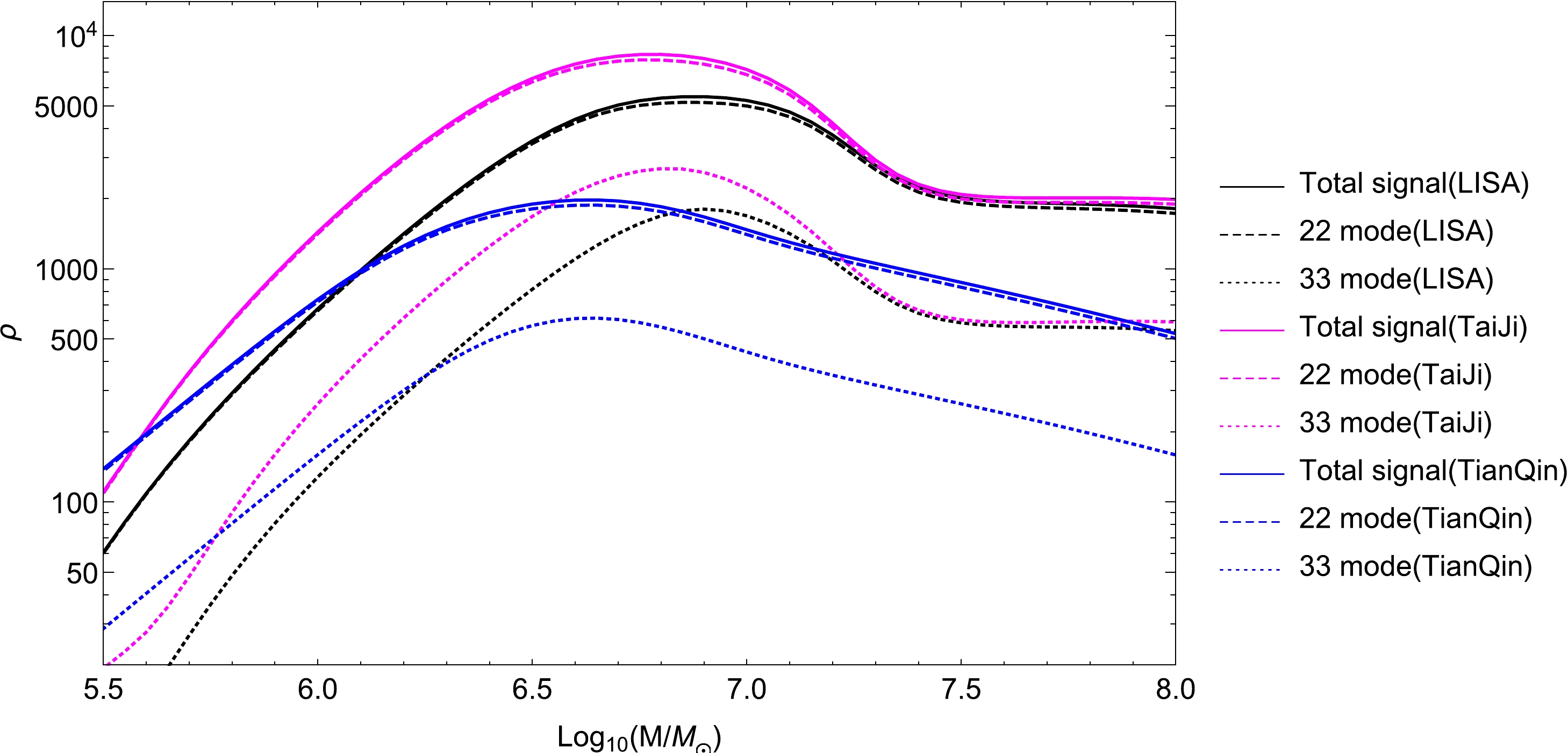
Figure 4. (color online) SNRs of LISA, TaiJi, and TianQin with the change in the mass for the ringdown signal. The calculations are performed with
${\chi _f} = 0.01,~{D_L} = 2.5 ~{\rm Gpc},~\nu = 2/9,~ $ $ {\phi _0} = 0,~\iota = \pi /3,~\zeta = 0.2$ .Next, we estimate the measurement errors for the dimensionless deviating parameter ζ (denoted by
$ \Delta \zeta $ ) via available tools. Before introducing the standard parameters of space-based gravitational wave detectors, we roughly evaluate the influence of the arm length of the detector on the dimensionless deviating parameter, where the residual acceleration noise is fixed and the displacement noise is proportional to the arm length for gravitational wave detection. Fig. 5 shows the measurement errors as a function of arm length for different sources of gravitational waves, where the maximum error of ζ is shown by a cyan dotted horizontal line, and the real arm lengths of LISA, TaiJi, and TianQin are shown by green dashed vertical lines. The test of EdGB gravity will be affected by sources of different masses. The arm lengths of TaiJi and LISA are more appropriate to test EdGB gravity for more massive black holes, whereas for less massive black holes, a more practical arm length can be provided by TianQin. Because the above are qualitative analyses, only the parameters related to LISA are used here to evaluate the ability to test EdGB gravity on the whole. For the specific calculation below, the standard parameters of space-based gravitational wave detectors are considered.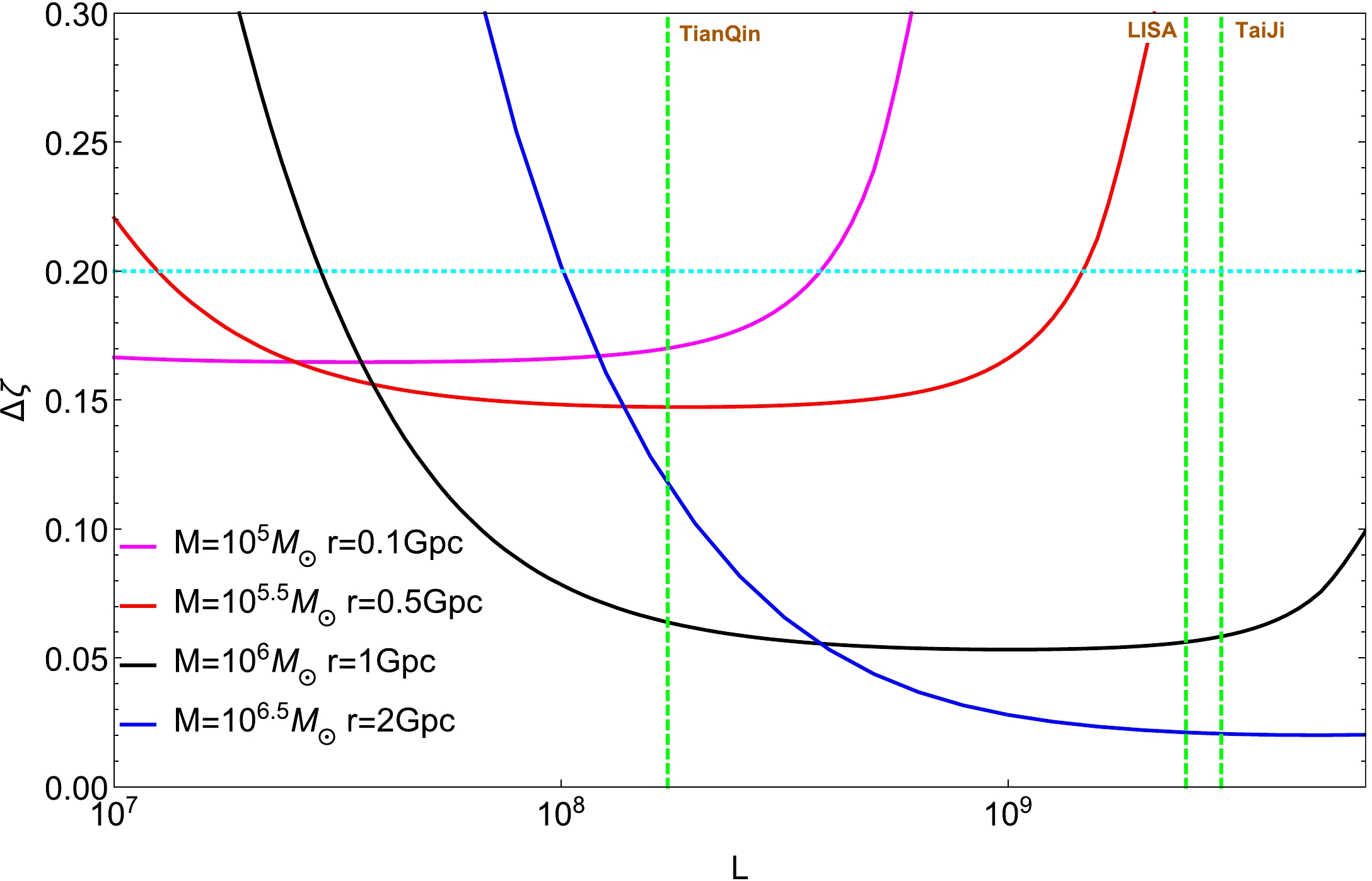
Figure 5. (color online) Dependence of parameter estimation accuracy
$ \Delta \zeta $ on the arm length of the detector L for different sources of gravitational waves. Here, we choose the basic parameters of LISA as a reference. The residual acceleration noise is fixed as${S_a} = 3 \times {10^{ - 15}}\;{\rm m{s^{ - 2}}}\;/\sqrt {\rm Hz}$ . The displacement noise is proportional to the arm length$ {S_x} \sim \alpha L $ , where$ \alpha = \dfrac{{1.5 \times {{10}^{ - 11}}}}{{2.5 \times {{10}^9}}} $ . The cyan dotted horizontal line represents the maximum error of ζ, and the green dashed vertical lines denote the real arm lengths of LISA, TaiJi, and TianQin. The calculations are performed with${\chi _f} = 0.01,~\nu = 2/9,~{\phi _0} = 0,~ $ $ \iota = \pi /3,~\zeta = 0.2$ .In addition, to explore how several source parameters, such as the mass
$ {{M}} $ , the luminosity distance$ {D_L} $ , the spin of the remnant black hole$ {{\chi _f}} $ , and the symmetric mass ratio ν, affect$ \Delta \zeta $ , we show the variation in$ \Delta \zeta $ with related parameters in Fig. 6. The top left plot of Fig. 6 shows the measurement errors as a function of the mass, where we assume that${\chi _f} = 0.01,~{D_L} = 2.5~{\rm Gpc},~ \nu = 2/9$ . As expected,$ \Delta \zeta $ first decreases with increasing$ {{M}} $ until arriving at the minimum value but soon increases with the accumulation of$ {{M}} $ for all detectors. For specific massive black holes, a slight bulge emerges in the measurement errors owing to the galactic confusion noise, which implies that galactic confusion noise plays a negative role in constraining EdGB gravity. It is clear that TianQin can constrain ζ more accurately for smaller masses, whereas TaiJi and LISA perform well for more massive black holes, which is also reflected by the sensitivity of the detectors. The measurement errors as a function of the luminosity distance are plotted in the top right plot of Fig. 6, where we fix$M ={10^7}{M_ \odot },~{\chi _f} = 0.01,~ \nu = 2/9$ . As shown,$ \Delta \zeta $ increases with increasing$ {D_L} $ , which is obvious because the SNR increases monotonically with decreasing distance. This is intuitively reflected in the ringdown waveform containing the term$ 1/{D_L} $ ; hence, there is a$ 1/{D_L}^2 $ in the error function after Fisher analysis. The bottom left plot of Fig. 6 presents the dependence of measurement errors on the spin of the remnant black hole, where we set$M ={10^7}{M_ \odot },~{D_L} = 2.5~{\rm Gpc},~ \nu = 2/9$ . Note that$ \Delta \zeta $ decreases extremely slowly as$ {{\chi _f}} $ increases. It is implied that the spin parameter of the black hole has little effect on measurement errors for EdGB gravity by detectors. The dependence of measurement errors on the symmetric mass ratio is illustrated in the bottom right plot of Fig. 6, where we choose$M ={10^7}{M_ \odot },~{D_L} = 2.5~{\rm Gpc},~{\chi _f} = 0.01$ . We observe that$ \Delta \zeta $ first decreases with increasing ν and then increases abruptly as ν approaches$ 0.25 $ . This is because radiated energy increases with large symmetric mass ratios, and as ν approaches$ 0.25 $ , the amplitude of the QNMs for$ (3,3) $ is zero. To estimate the associated parameters better, it is necessary to avoid selecting ν in this limit or replace it with other dominant modes.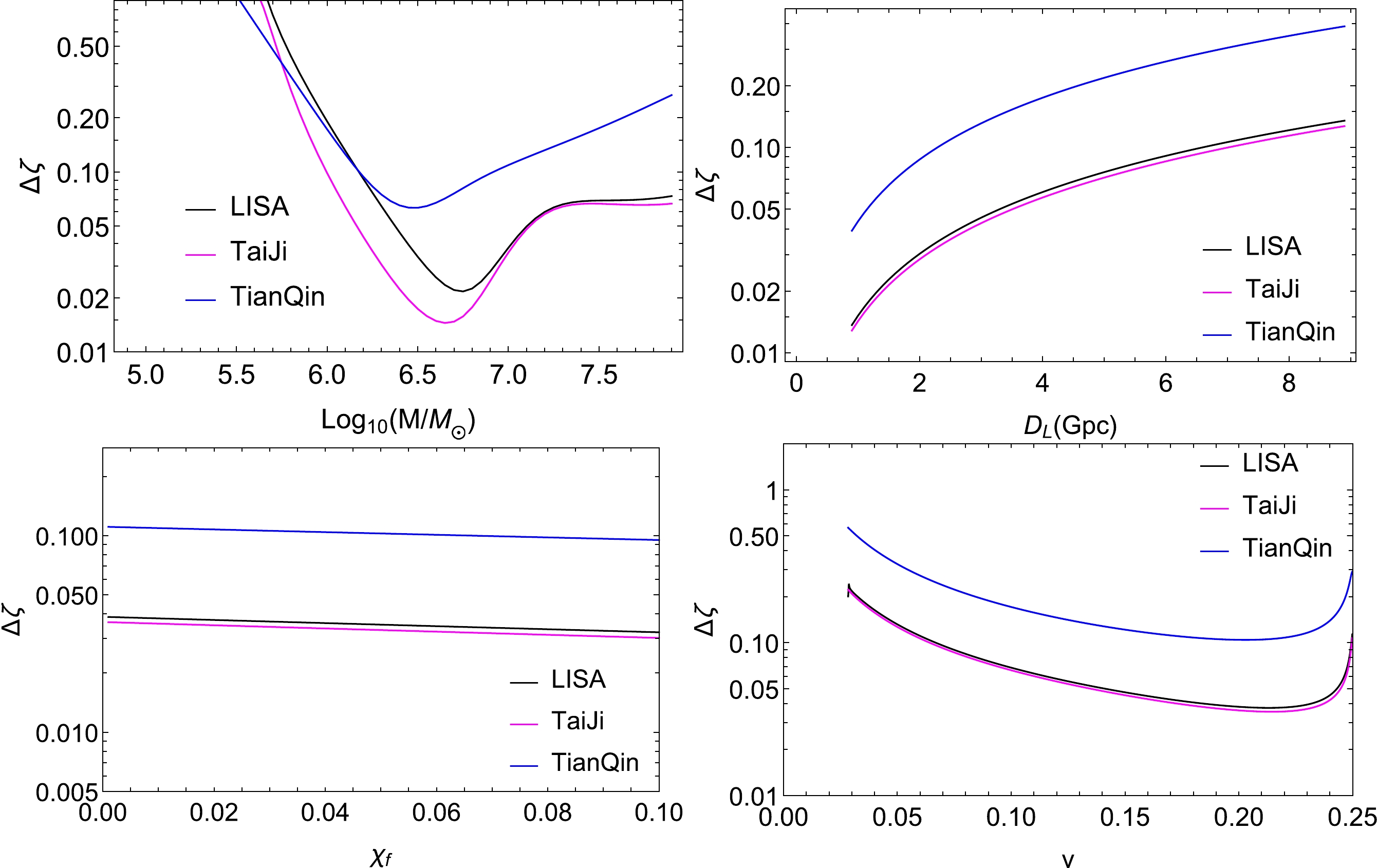
Figure 6. (color online) Dependence of parameter estimation accuracy
$ \Delta \zeta $ on the mass M (top left), the luminosity distance$ {D_L} $ (top right), the spin of the remnant black hole$ {{\chi _f}} $ (bottom left), and the symmetric mass ratio ν (bottom right). The black, magenta, and blue curves represent the errors detected by LISA, TaiJi, and TianQin, respectively. Other parameters used are${\phi _0}=0,~\iota = \pi /3,~\zeta = 0.2$ .In particular, we pay attention to how the measurement errors
$ \Delta \zeta $ varies with ζ, which is illustrated in Fig. 7. As shown, the effect of$ \Delta \zeta $ on ζ is dynamic because ζ is nonlinear in Eqs. (4) and (5). Owing to the relatively large coefficients in Table 1, higher-order corrections are not discarded here. Hence, the result of the covariance matrix contains variable ζ, and specifically,$ \Delta \zeta $ decreases with increasing ζ. When the dimensionless deviating parameter is small, it is difficult to distinguish EdGB gravity from general relativity owing to the larger uncertainty of ζ. We emphasize this problem by tracing the maximum error of ζ in EdGB gravity (denoted by$ \Delta {\zeta _{\max }} $ ), namely, the solution of the equation$ \Delta {\zeta } = \zeta $ , which is treated as the maximum constraint of the detector by probing a particular wave source, marked as red dots. Only in the area below that do space-based gravitational wave detectors have the potential to tell the difference between EdGB gravity and general relativity. Because there is no significant difference in the standard parameters of the space-based gravitational wave detector between TaiJi and LISA, for comparison purposes, the remainder of our paper focuses only on the results of LISA and TianQin. Furthermore, to investigate the maximum constraint on the dimensionless deviating parameter for EdGB gravity with LISA and TianQin, we show the density plots of$ \Delta {\zeta _{\max }} $ in the${\rm lg}({D_L}/{\rm Gpc}) - {\rm lg}({M}/{M_ \odot })$ plane in Fig. 8. We observe that ζ can be best constrainted with LISA for$ {M} \sim 5.5 \times {10^6}{M_ \odot } $ and TianQin for$ {M} \sim 3 \times {10^6}{M_ \odot } $ . Moreover,$ \Delta \zeta $ decreases with increasing SNR, which is demonstrated in Fig. 9. For a considerably smaller deviation from general relativity, we must count on detectors with larger SNRs to obtain the maximum constraint. The increase in the required SNR is not linear, and as the accuracy of the constraints increases, the SNR increases dramatically. Compared with TianQin, LISA is noticeably more likely to give an optimal constraint in the future.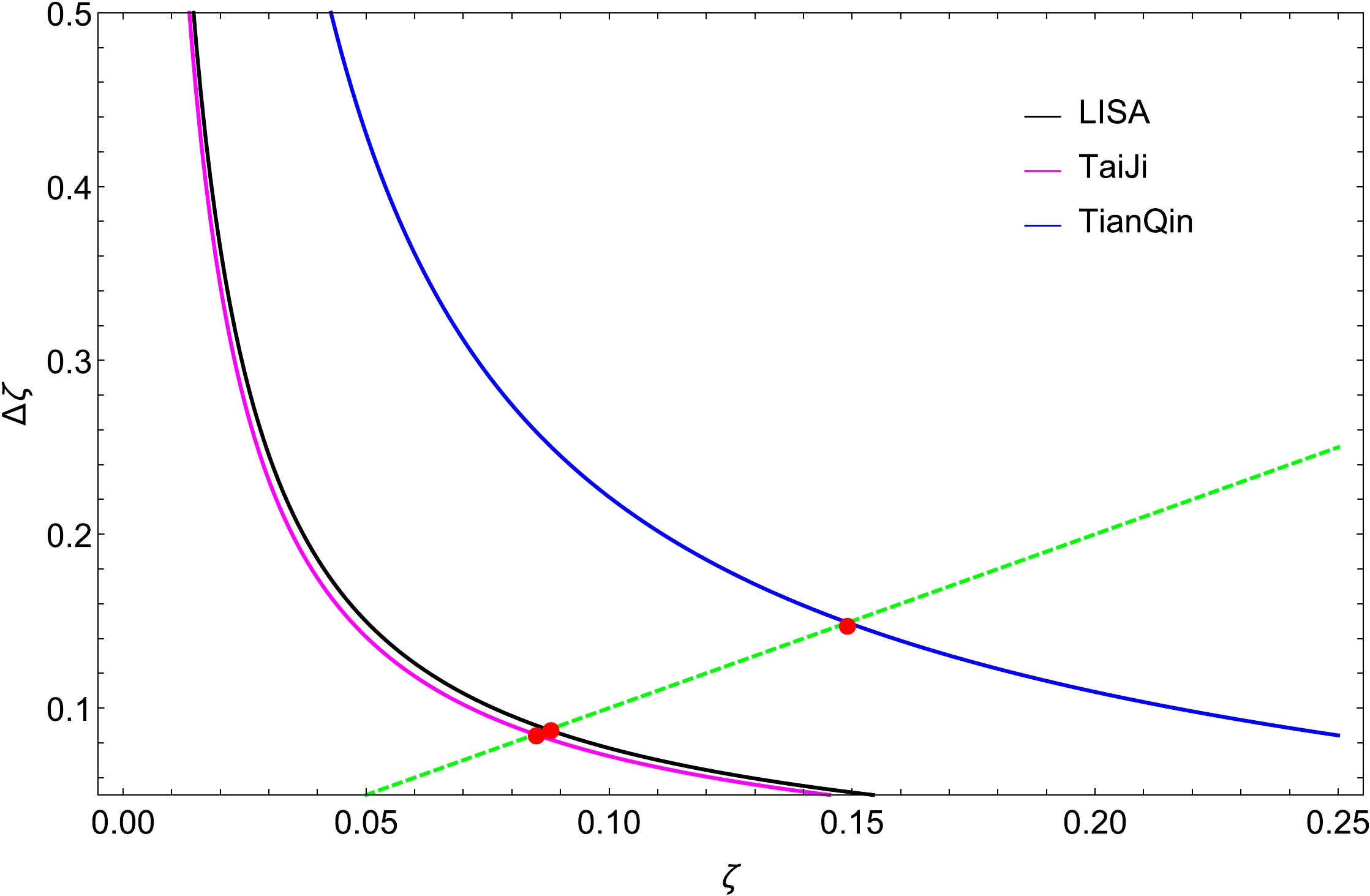
Figure 7. (color online) Dependence of parameter estimation accuracy
$ \Delta \zeta $ on the dimensionless deviating parameter ζ. The green dashed line denotes$ \Delta \zeta = \zeta $ . The red intersections are$ \Delta {\zeta _{\max }} $ for each detector. The profiles are obtained with$M = {10^7}{M_ \odot },~{\chi _f} = 0.01,~{D_L} = 2.5~{\rm Gpc},~\nu = 2/9,~{\phi _0} = 0,~\iota = \pi /3$ for different space-based gravitational wave detectors.
Figure 8. (color online) Maximum constraint on the dimensionless deviating parameter for EdGB gravity with LISA and TianQin in the
${\rm lg}({D_L}/{\rm Gpc}) - {\rm lg}({M}/{M_ \odot })$ plane. The calculations are performed for the case of${\phi _0} = 0,~\iota = \pi /3,~\nu = 2/9,~{\chi _f} = 0.01$ . -
To verify the results calculated in the Fisher information matrix analysis, we employ the Bayesian inference method to analyze the simulated source. The Bayesian inference method is widely used to estimate the probability distribution of unknown parameters from sampled data containing signals and noise, which is instrumental in astrophysical and cosmological analyses. Unlike Fisher information matrix analysis, which is limited to large SNRs, Bayesian analysis is applicable to a wider range of situations. Furthermore, Bayesian posterior probability distributions provide more information. The disadvantage is that it is more computationally intensive. In essence, Bayesian statistics involves creating a likelihood to associate unknown and measurement parameters. Then, the probability distribution of the unknown parameters will be updated through the distribution of measurement data. This process is based on Bayes' theorem:
$ \begin{equation} P(\vec \theta |d) = \frac{{\pi (\vec \theta ) \mathcal{L}(d|\vec \theta )}}{{p(d)}}, \end{equation} $

(23) where
$ P(\vec \theta |d) $ is the posterior probability of the set of free parameters,$ d = h({\vec\theta _0}) + n $ represents the measurement data, which collects the gravitational-wave signal modeled by all the true parameters$ \vec\theta _0 $ and detector noise n modeled by the noise power spectra,$ {\pi (\vec \theta)} $ is the prior probability of$ \vec \theta $ ,$ {p(d)} $ is a normalization constant, which is also called the evidence of d, and$ {\mathcal{L}(d|\vec \theta)} $ is the likelihood, which can be written as$ \begin{equation} \mathcal{L}(d|\vec \theta ) = \exp \left[ { - \frac{1}{2}(h(\vec \theta ) - {\rm d}|h(\vec \theta ) - {\rm d})} \right]. \end{equation} $

(24) The amplitudes of the strain data for ringdown and the noise power spectra for LISA and TianQin are illustrated in Fig. 10. As shown, the highest peak corresponds to mode
$ (2,2) $ . By comparison, the noise power spectrum of TianQin reaches the lowest level in the present frequency band.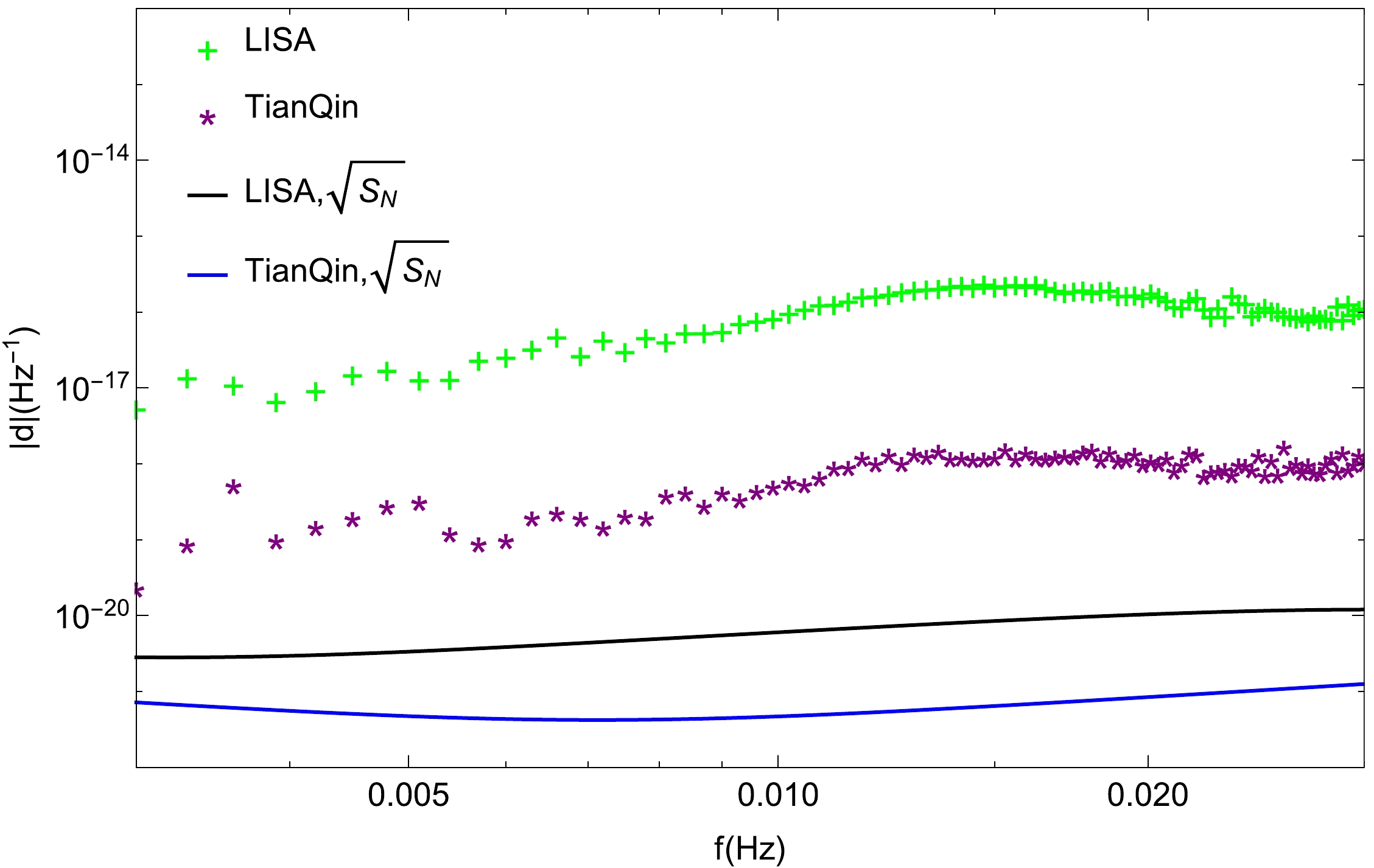
Figure 10. (color online) Amplitudes of the strain data d for ringdown and the noise power spectra for LISA and TianQin. The results are obtained using the parameters
$M = 6 \times {10^6}{M_ \odot }, $ $ {\chi _f} = 0.01,\;~{D_L} = 2.5~{\rm Gpc},\;~\nu = 2/9,\;~{\phi _0} = 0,~\iota = \pi /3,~ \zeta = 0.2.$ After generating simulation data, we utilize the Bayesian inference method to obtain the probability distributions of the source parameters, including
${\rm lg}({M}/{M_ \odot })$ ,$ {\chi _f} $ ,${D_L}/{\rm Gpc}$ , ν,$ {\phi _0 } $ , ι, and ζ. Fig. 11 shows the posterior distribution for the ringdown signal with LISA, where the true parameters for the ringdown signal are set as${M} = {10^{6.5}}{M_ \odot },~{\chi _f} = 0.1,~{D_L} = 10~{\rm Gpc},~\nu = 2/9,~{\phi _0 }=0,~\iota = \pi /3,$ $\zeta = 0.2 $ . The priors of the corresponding parameters are set as uniform distributions within the ranges$ [6,7] $ ,$ [0.001,0.2] $ ,$ [9,14] $ ,$ [0,1/4] $ ,$ [0,2\pi ] $ ,$ [0,\pi ] $ ,$ [0,0.4] $ , respectively. For comparison, the results for the same wave source with TianQin are shown in Fig. 12. As shown, the probability distribution for$ {D_L} $ is relatively poor, even if we set a narrower prior. If a broad priori is set, the estimation accuracy of$ {D_L} $ is even worse. Its estimation affects the estimation accuracy of other parameters. Fortunately, the ringdown signal is usually spotted after the inspiral and merger, which will provide an estimate of the luminosity distance. Now that we focus only on the probability distribution for ζ, Fig. 13 shows the posterior possibility of ζ for LISA and TianQin with different luminosity distances to the source. As shown on the left side of Fig. 13, the luminosity distance is$10~{\rm Gpc}$ , and the dimensionless deviating parameter cannot be distinguished from 0. The 95% credible upper limit given by different detectors is 0.385 for LISA and 0.387 for TianQin. For the right subplot, all parameters remain the same, except the luminosity distance is reduced to$0.5~{\rm Gpc}$ . For such a signal with an extremely large SNR (over 1000), space-based detectors can distinguish between the dimensionless deviating parameter and 0 by the ringdown signal. The estimate for the dimensionless deviating parameter with both detectors is$ 0.1943^{+0.0287}_{-0.0216} $ for LISA and$ 0.1727^{+ 0.0402}_{- 0.0292} $ for TianQin. It is clear that LISA can provide the best limit. The posterior possibility of ζ at shorter luminosity distances is found to be better than that at longer luminosity distances, which implies that possible constraints to ζ become more accurate at high SNRs. The uncertainty of the dimensionless deviating parameter for different detectors matches the results of the Fisher information matrix.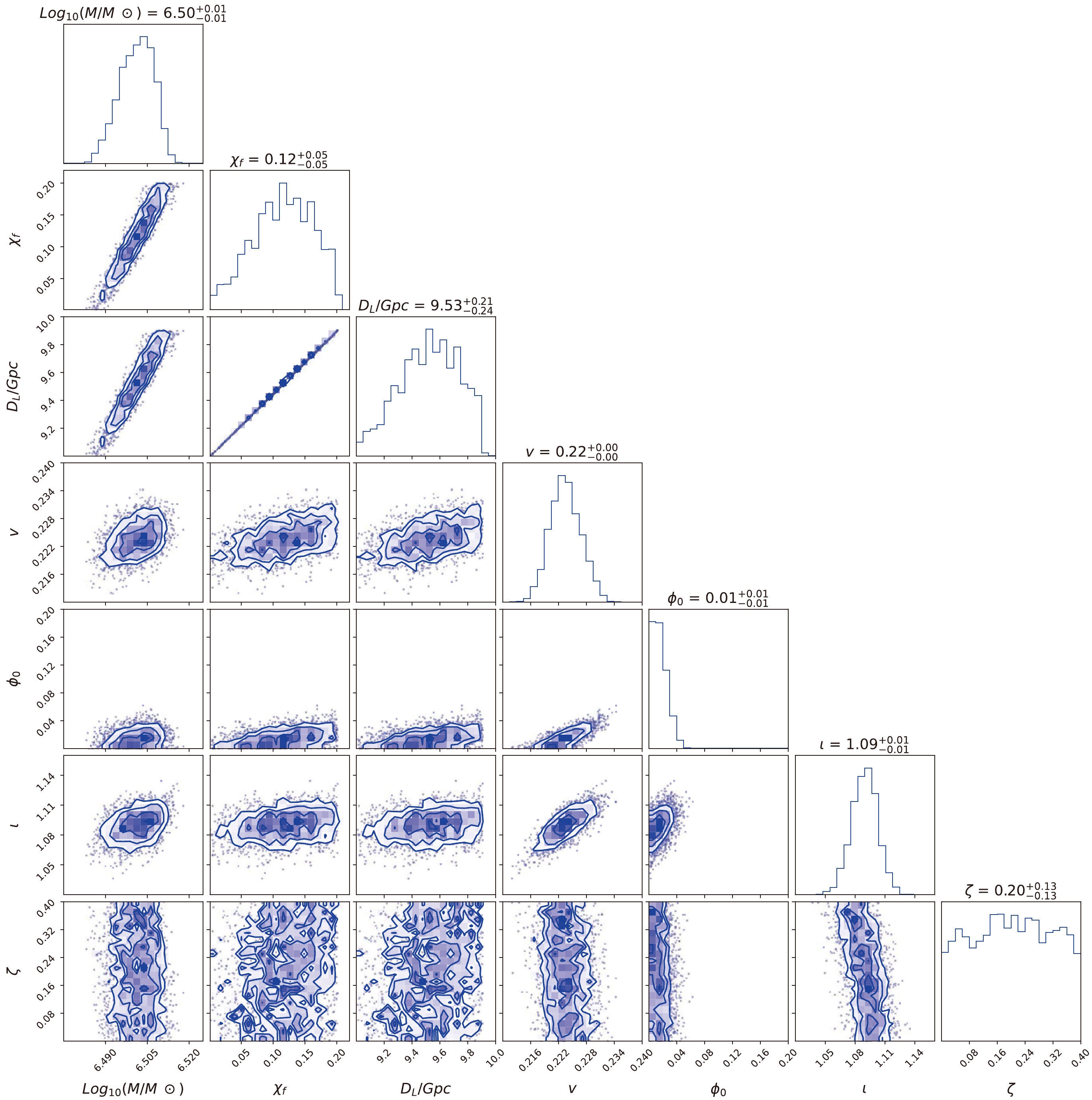
Figure 11. (color online) Posterior distribution for the ringdown signals with LISA. The true parameters are set as
${M} = {10^{6.5}}{M_ \odot }, $ $ {\chi _f} = 0.1,~{D_L} = 10~{\rm Gpc},~\nu = 2/9,~{\phi _0} = 0,~\iota = \pi /3,~\zeta = 0.2$ .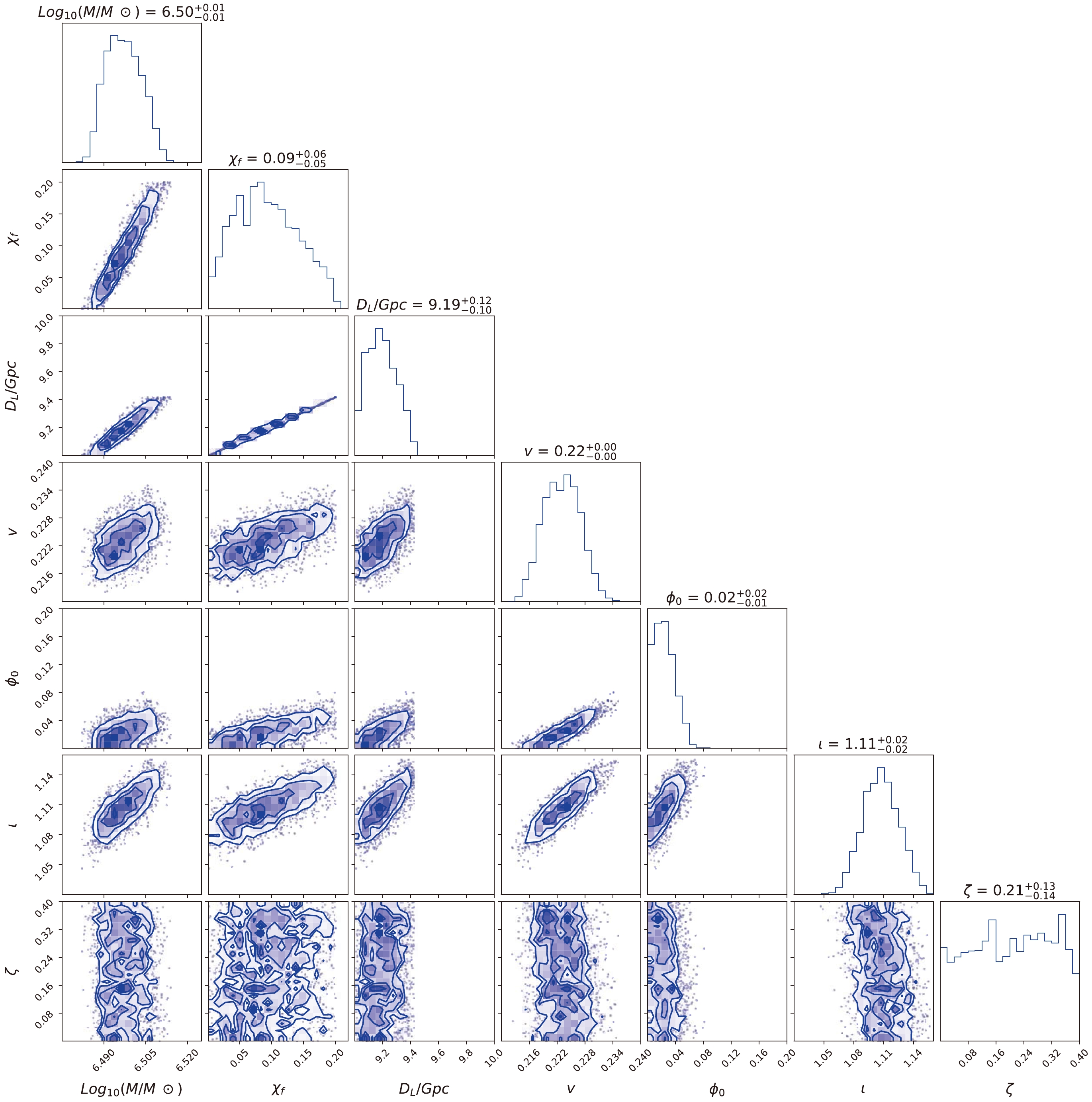
Figure 12. (color online) Posterior distribution for the ringdown signals with TianQin. The true parameters are set as
${M} ={10^{6.5}}{M_ \odot }, $ $ {\chi _f} = 0.1,~{D_L} = 10~{\rm Gpc},~\nu = 2/9,~{\phi _0} = 0,~\iota = \pi /3,~\zeta = 0.2$ .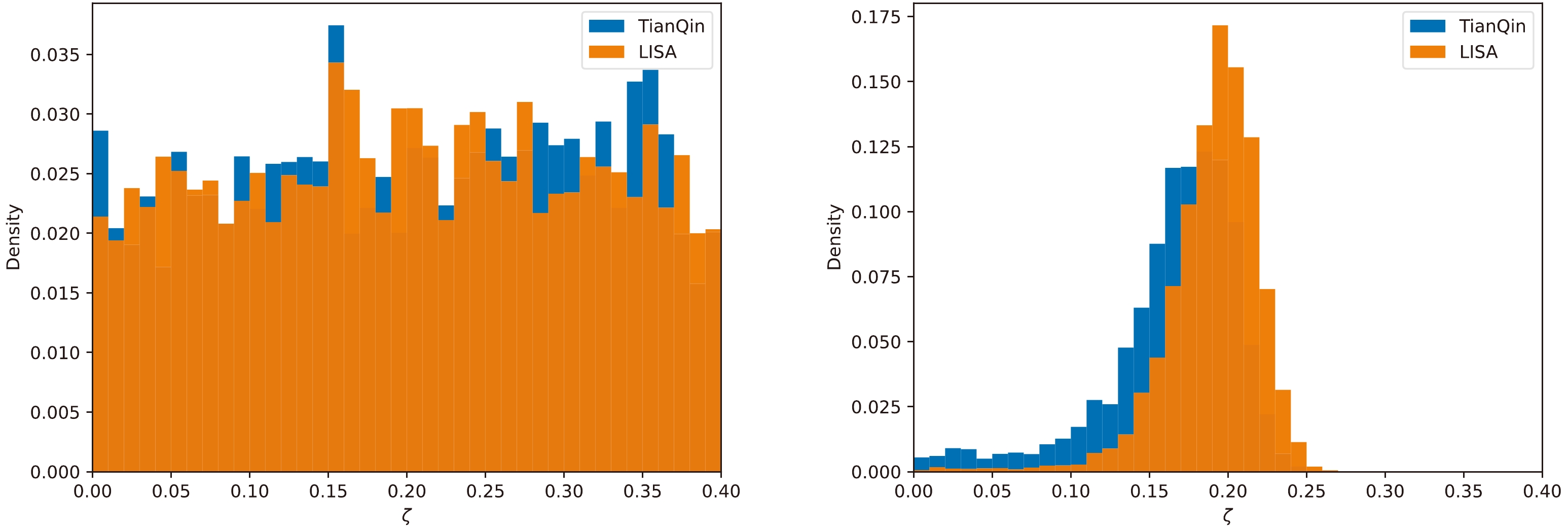
Figure 13. (color online) Posterior distribution of ζ for LISA and TianQin. The true parameters are set as
${M} = {10^{6.5}}{M_ \odot },~{\chi _f} = 0.1, $ $ \nu = 2/9,~{\phi _0 } = 0,~\iota = \pi /3,~\zeta = 0.2$ . We set${D_L} = 10~{\rm Gpc}$ for the left plot and${D_L} = 0.5~{\rm Gpc}$ for the right plot. -
In this study, we analyze the ability of the space-based gravitational-wave detectors LISA and TianQin to constrain the dimensionless deviating parameter for EdGB gravity by detecting ringdown signals. The detection capabilities of different detectors for ringdown signals are first evaluated and compared. The ringdown waveform is parameterized using several of the strongest modes in EdGB gravity. We adopt the TDI Michelson combination X to conduct scientific performance evaluations for space-based detectors. Based on the SNR distributions of LISA, TaiJi, and TianQin, TianQin is more sensitive to ringdown signals for the less massive black holes, whereas TaiJi and LISA are more reliable in detecting signals for more massive black holes. For specific massive black holes, the effect of galactic confusion noise plays an important role in the detection signal, and this effect is insignificant for TianQin compared to TaiJi and LISA.
To estimate the measurement accuracy of the dimensionless deviating parameter, we first use Fisher information matrix analysis to qualitatively study the influence of the arm length of the detector on the measurement errors and then explore how the constraints on the dimensionless deviating parameter are affected by the source parameters, such as the mass, the luminosity distance, the spin of the remnant black hole, and the symmetric mass ratio. In particular, we find that the measurement errors of the dimensionless deviating parameter increase as the dimensionless deviating parameter decreases. To distinguish between EdGB gravity and general relativity, it is necessary to determine whether the dimensionless deviating parameter is 0, which requires its uncertainty to be less than the value of the parameter itself. For a given source, the critical value at which the uncertainty is equal to the dimensionless deviating parameter is the upper limit of the detector's ability to constrain the dimensionless deviating parameter for EdGB gravity. We present the maximum capability of the detectors to constrain the dimensionless deviating parameter with the distribution of the wave source. LISA has more potential to constrain the dimensionless deviating parameter to an accurate level for massive binary black hole mergers, whereas TianQin performs better for smaller black holes.
In addition, to verify the conclusion obtained through the Fisher information matrix analysis, we perform Bayesian parameter estimation on the simulated data. We find that the posterior possibility of ζ becomes better as the luminosity distance decreases. As indicated by a comparison, LISA might be better able to constrain the dimensionless deviating parameter for massive black holes because the sensitivity in this frequency band is lower than that of other detectors. These results may be helpful in testing EdGB gravity with future space-based gravitational wave detectors. For a more realistic black hole with bigger spins, it will be interesting to generalize the research to explore the SNR and estimate the deviating parameters.
Parameter estimation for Einstein-dilaton-Gauss-Bonnet gravity with ringdown signals
- Received Date: 2023-06-14
- Available Online: 2023-10-15
Abstract: Future space-based gravitational-wave detectors will detect gravitational waves with high sensitivity in the millihertz frequency band, providing more opportunities to test theories of gravity than ground-based detectors. The study of quasinormal modes (QNMs) and their application in gravity theory testing have been an important aspect in the field of gravitational physics. In this study, we investigate the capability of future space-based gravitational wave detectors, such as LISA, TaiJi, and TianQin, to constrain the dimensionless deviating parameter for Einstein-dilaton-Gauss-Bonnet (EdGB) gravity with ringdown signals from the merger of binary black holes. The ringdown signal is modeled by the two strongest QNMs in EdGB gravity. Considering time-delay interferometry, we calculate the signal-to-noise ratio of different space-based detectors for ringdown signals to analyze their capabilities. The Fisher information matrix is employed to analyze the accuracy of parameter estimation, with particular focus on the dimensionless deviating parameter for EdGB gravity. The impact of the parameters of gravitational wave sources on the estimation accuracy of the dimensionless deviating parameter is also studied. We find that the constraint ability of EdGB gravity is limited because the uncertainty of the dimensionless deviating parameter increases with a decrease in the dimensionless deviating parameter. LISA and TaiJi offer more advantages in constraining the dimensionless deviating parameter to a more accurate level for massive black holes, whereas TianQin is more suited to less massive black holes. The Bayesian inference method is used to perform parameter estimation on simulated data, which verifies the reliability of the conclusion.





 Abstract
Abstract HTML
HTML Reference
Reference Related
Related PDF
PDF











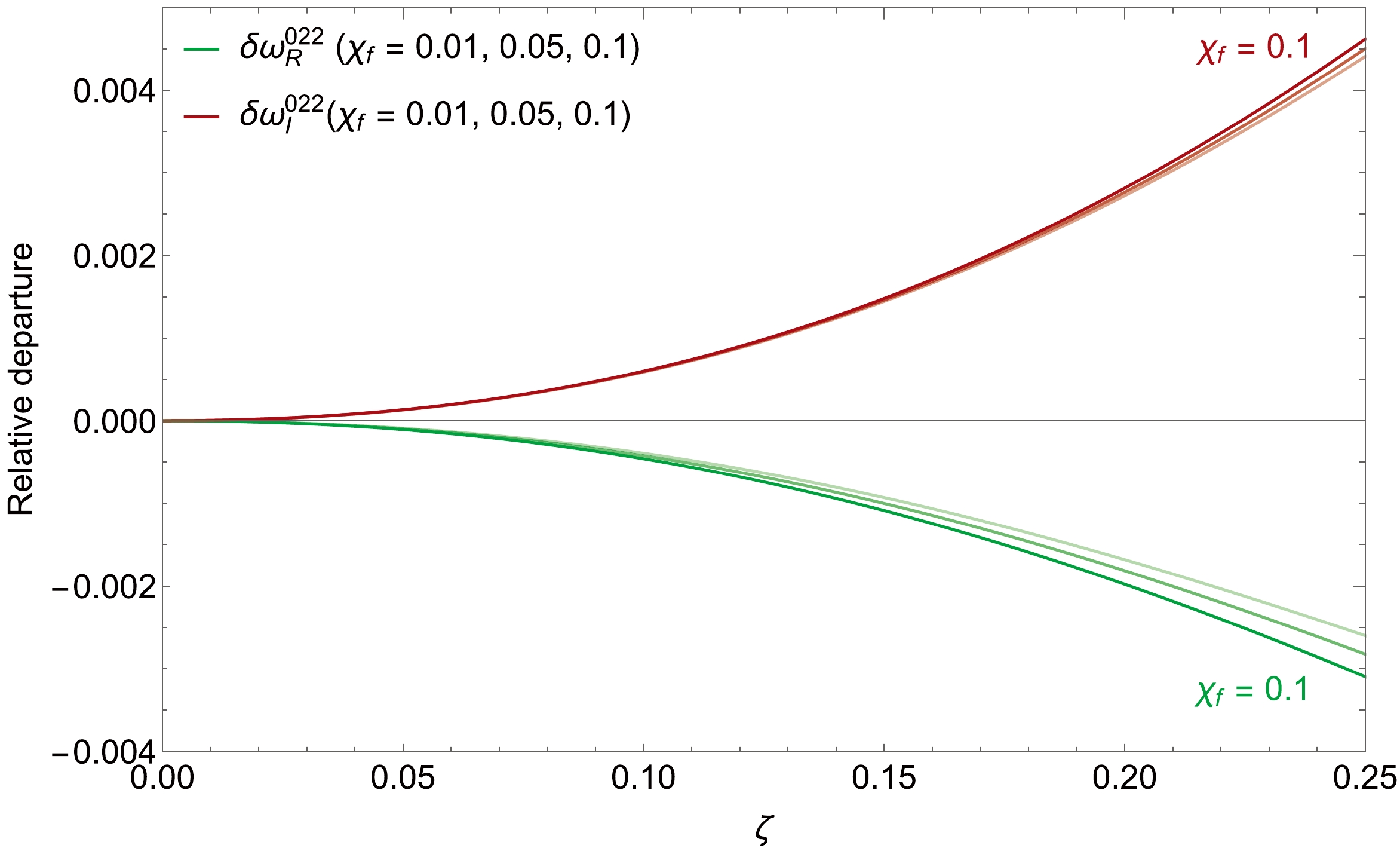
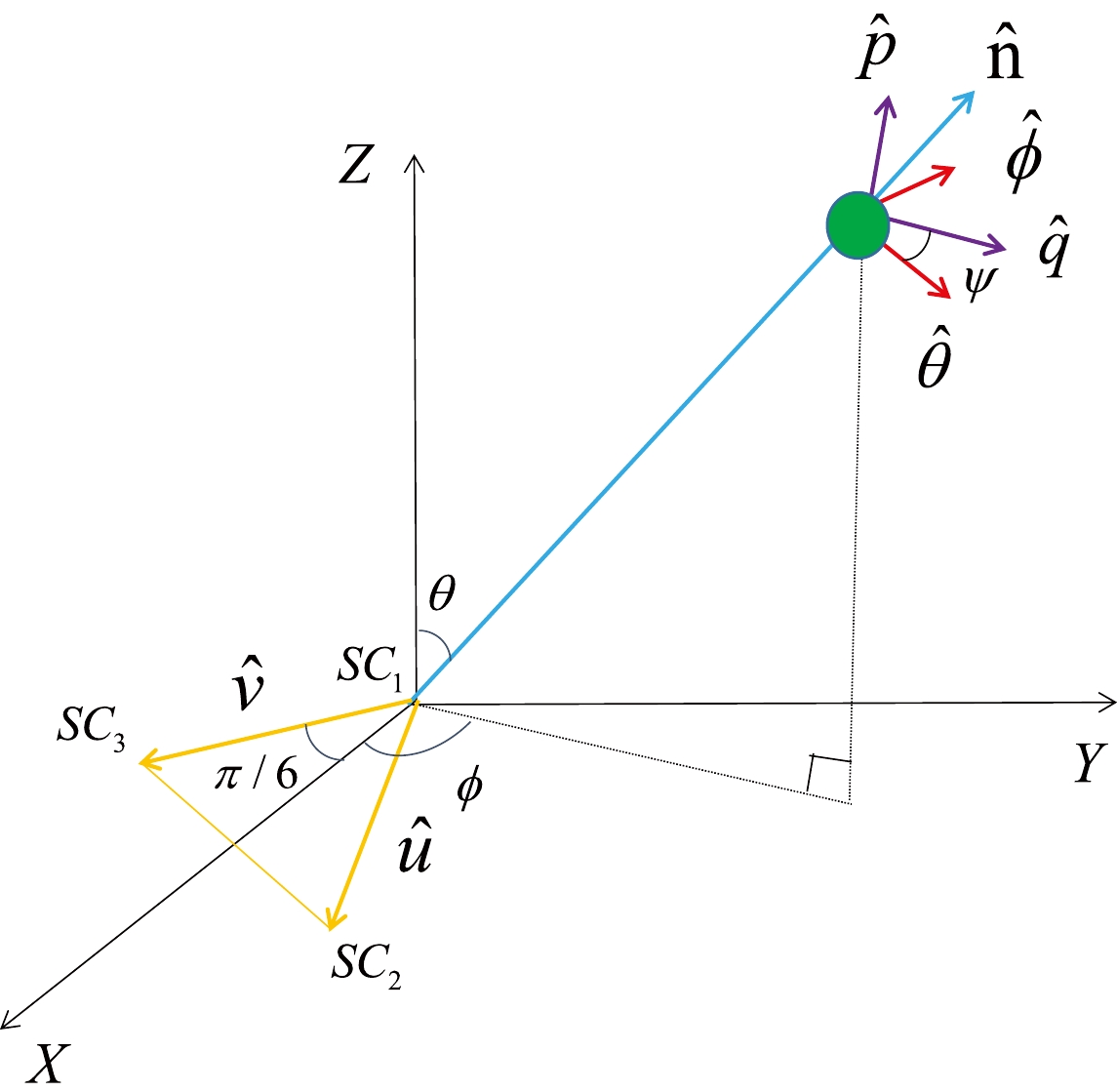
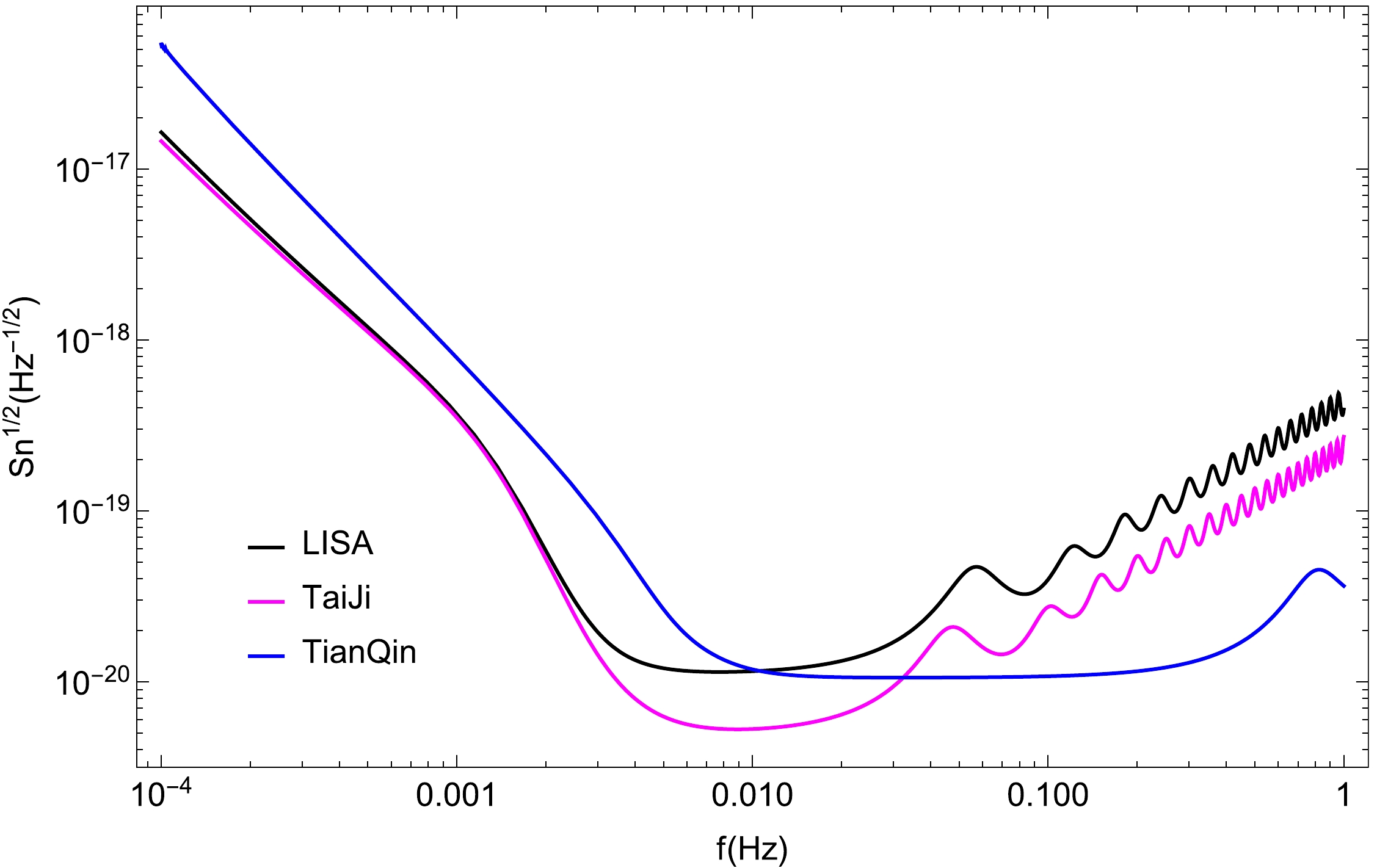
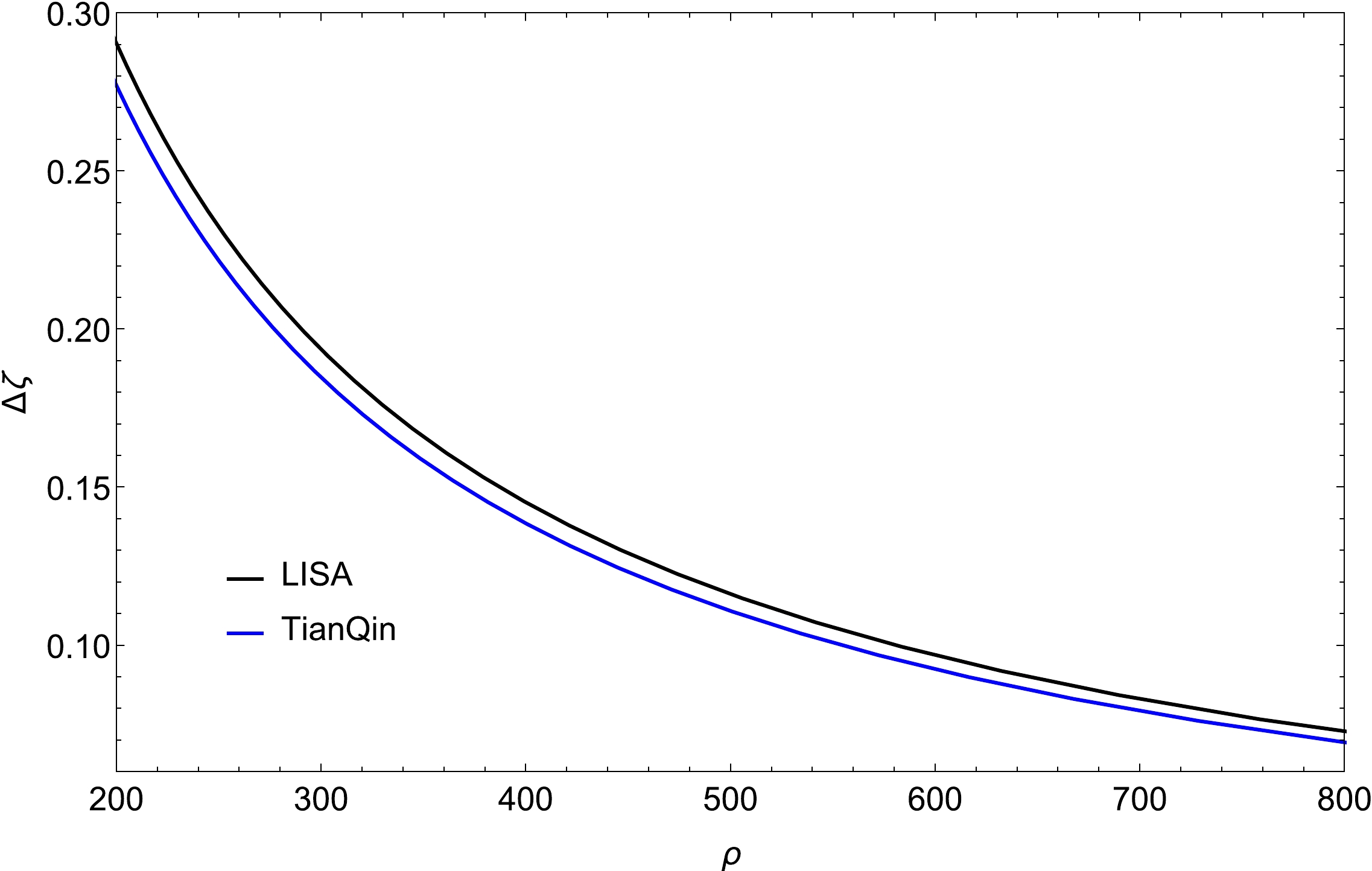



 DownLoad:
DownLoad: